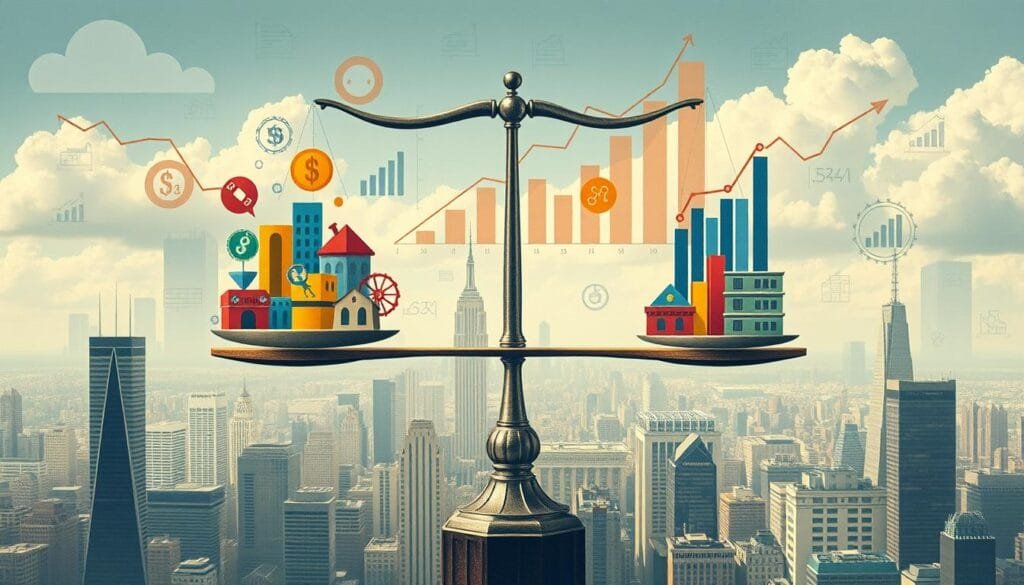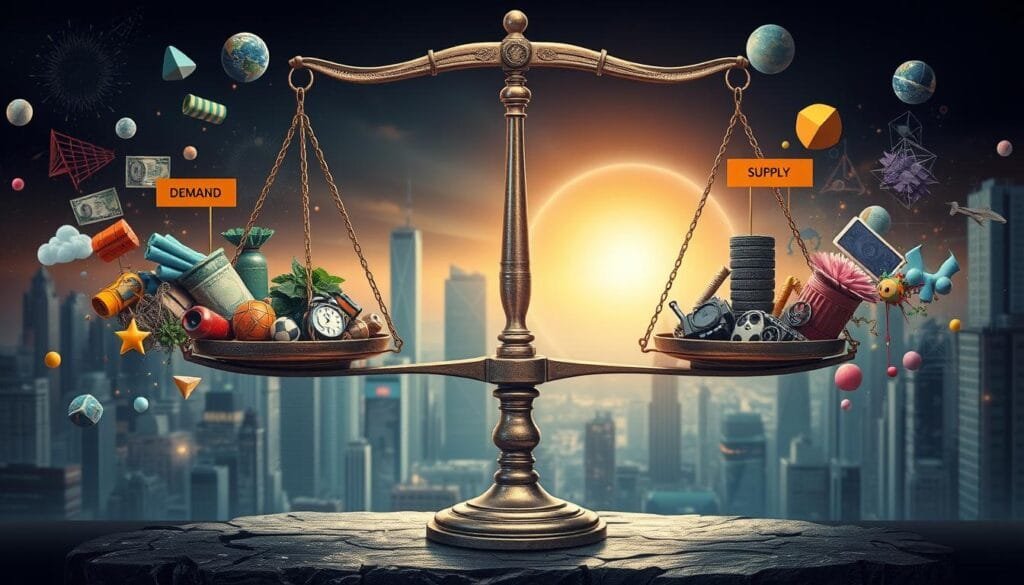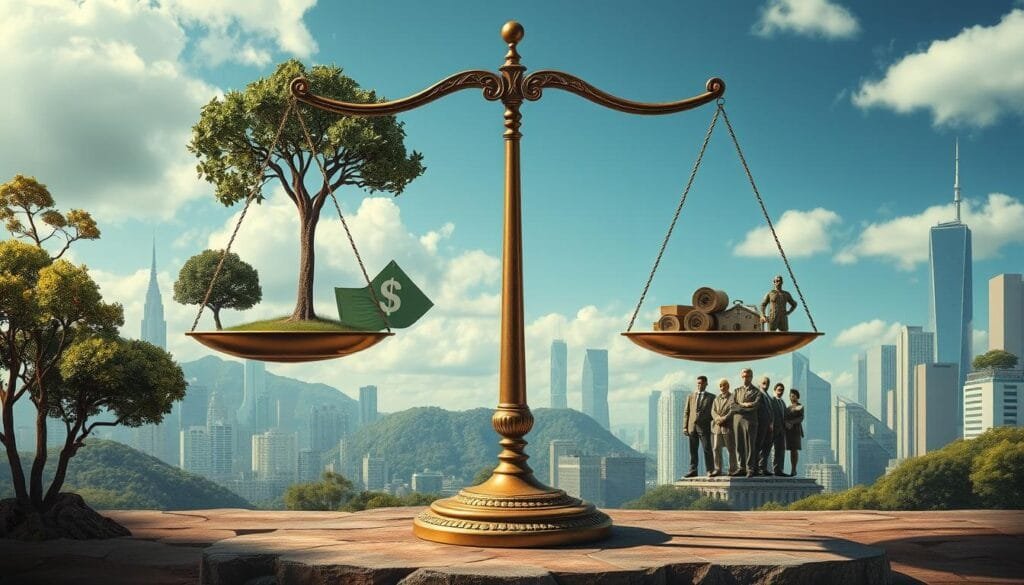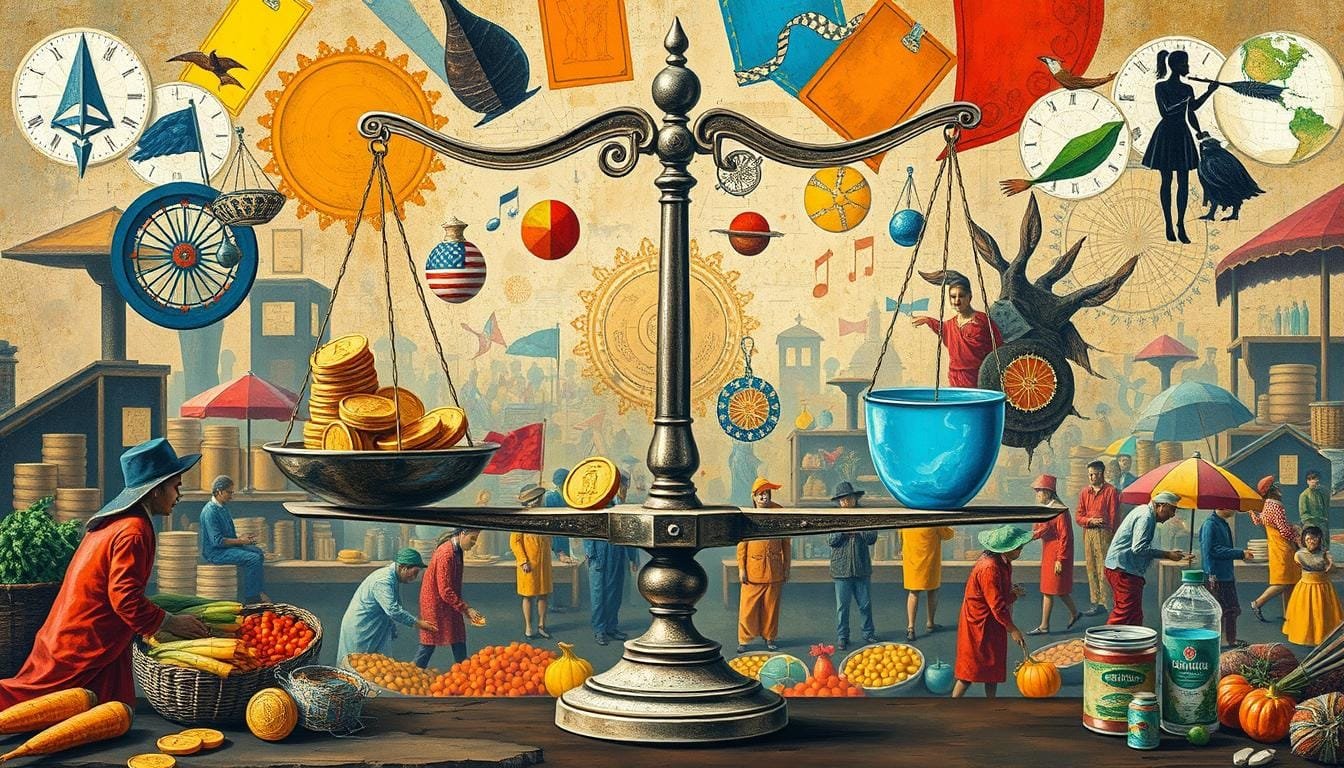Have you ever wondered why governments cut healthcare funds to increase education spending? Or why a small business might favor new technology over hiring more employees? These choices are all about trade-offs in economics. To really get economics, we need to look into these trade-offs. They’re key to making decisions, involving opportunity costs and how resources are used.
This article will clear up many questions about trade-offs. These trade-offs don’t just affect governments and companies, but also our everyday lives. By getting to grips with economic principles, we understand how our choices matter. We see the big role trade-offs play in making economic decisions.
Consider the idea of opportunity cost. This concept says that when we choose one option, we miss out on another. For example, when developing countries spend more on infrastructure than education, it’s a clear case. Discover more about how countries juggle their economic needs with the trade-offs in international trade. Check out the detailed examples.
Key Takeaways
- Opportunity cost is the loss from not choosing the next best option.
- Trade-offs in economics affect many areas like health, education, and building projects.
- Getting how trade-offs work helps in using resources better, which is key for growth and well-being.
- Production Possibility Frontiers show how to make various goods efficiently with limited resources.
- Understanding trade-offs is vital in economics, as it shapes the cost of different economic decisions.
What is Meant by Trade-Off in Economics
Trade-offs are key to understanding decisions in economics. They show how choices are made when resources are scarce. To get more of something, something else must be given up. This reflects how resources are allocated.
This idea is vital when looking at the benefits and costs of different options. For instance, countries trade internationally. They import goods that are cheaper from abroad. They export what they can make more efficiently. This shows the principle of comparative advantage.
Definition of Trade-Off
The definition of trade-off means bigger gains in one area require sacrifices in another. This is true in many economic situations. From how resources are shared to the choices policy makers make.
Businesses might choose between buying machines or investing in consumer goods. Machines last longer but lose value. Consumer goods need replacing but offer fast rewards. The choice affects economic growth.
Examples of Trade-Offs in Daily Life
Trade-offs happen every day, showing how we use limited resources. Choosing to work extra hours or spend time with family is one example. It reflects basic economic ideas.
Big trash cans mean less trash duty but might smell bad from rotten food. Mittens are warmer than gloves. But gloves give better finger movement. These trade-offs affect our choices and how we manage resources.
| Trade-Off Example | Benefit | Cost |
|---|---|---|
| Working Overtime | Increased Salary | Less Family Time |
| Larger Trash Cans | Less Frequent Disposal | Odor Issues |
| Mittens vs. Gloves | Better Warmth | Reduced Dexterity |
Economic trade-offs show the need to balance our needs and wants. This balancing is crucial for personal decisions, economic policies, and how resources are shared.
Importance of Trade-Offs in Economic Decision Making
Knowing about significance of trade-offs is key in making economic choices. This is true especially when we have limited things to work with. When we choose one option over another, we face what’s called opportunity costs. For example, if you decide to study instead of work, you might miss out on earning money.

Every day, we make choices like whether to walk or drive. These decisions carry trade-offs regarding our time and ease. This idea is also seen in businesses. Here, firms weigh the benefits and risks of their economic decisions. They might compare the gain from an investment to the match between a job candidate and the company’s culture.
The “guns versus butter” model shows a big choice on a national level. More military goods mean less for other areas due to limited resources. When the government plans its budget, picking one area to fund more can mean less for others. For example, spending more on schools might mean less for health care.
Looking closely at trade-offs can help a lot. It can make better use of resources and boost profits. Good choices are based on clear factors and measuring these options. Tools like 1000minds help in evaluating complex scenarios with many people involved.
Economic choices often boil down to weighing the significance of trade-offs. This could be between fairness and efficiency or jobs and inflation levels. Trying to boost efficiency might reduce fairness. Lowering unemployment might lead to higher prices.
Understanding trade-offs is vital for coming up with new solutions. It helps people and businesses make smarter economic decisions. By knowing and carefully dealing with these trade-offs, better and more informed choices are made.
| Trade-Off Scenario | Opportunity Cost | Example of Impact |
|---|---|---|
| Education vs Employment | Foregone wages | Potential income loss |
| Walking vs Driving | Time expenditure | Loss of convenience |
| Investing in Technology vs Workforce Training | Productivity and competitiveness | Enhanced or reduced business performance |
| Guns vs Butter (Military vs Consumer Goods) | Economic returns | National security vs standard of living |
| Government Budget Allocation | Resource distribution | Sectoral impacts (e.g., healthcare, education) |
Trade-Offs in Resource Allocation
Learning about trade-offs is very important, especially for smart resource allocation. All choices in the economy show trade-offs. It’s about finding a balance. This means understanding scarcity in economics. Resources are limited and we must carefully decide how to use them for different wants and needs.

Opportunity Cost Explained
The idea of opportunity cost is key to get trade-offs. It is what you give up when you choose one thing over another. For example, a business choosing between investing in research or marketing has to think about the benefits and risks. These choices really impact how resources are used.
Look at these examples of opportunity cost:
- A government picking what to fund more, like education, healthcare, or roads.
- Choosing to buy a new phone for $800 or keeping the money for an emergency.
- Countries making certain goods they are good at producing.
Scarcity and Choices
Scarcity in economics means we have to choose because we don’t have enough for all wants. This affects many decisions:
- Government policy: Leaders have to decide what to spend on, like healthcare or education. They aim to use limited resources for the greatest good.
- Personal budgeting: People often choose between spending now or saving for later. Spending on fun might risk future financial safety.
- Environment: Choosing eco-friendly practices can cost more now but is better for the future.
Trade-offs show every economic choice has a cost. Looking at these costs helps use resources well.
Resource Allocation Decisions
| Scenario | Opportunity Cost | Impact |
|---|---|---|
| Investing in Education vs. Healthcare | Potential healthcare advancements lost | Improved education system but slower health sector improvements |
| Spending on Luxury Item vs. Saving | Future financial security compromised | Immediate gratification but potential future financial strain |
| Short-term Profits vs. Sustainable Practices | Immediate profit reduction | Long-term environmental sustainability and business resilience |
Trade-Offs in Public Policy
In public policy decisions, understanding trade-offs is key. These often involve resource allocation, where balancing interests is crucial. Budget decisions show this clearly, as officials choose which programs get money and which do not, affecting people differently.
After World War II, the U.S. led economically with little competition. But now, that consensus for global engagement has weakened. This change has influenced policies, especially under Trump and Biden, towards strategies like tariffs.
Policy decisions impact areas like healthcare and education significantly. Recognizing these impacts is vital for forming effective policy. For example, securing funds for development is tough. Our economic-security policies also require careful consideration of their costs and benefits.
Energy policy shows trade-offs, too. After the Three Mile Island event, nuclear power use did not grow. Shutting down nuclear plants has led to more pollution and health risks. This shift to coal plants shows the tough choices in policy making.

The end of nuclear power in Japan, post-Fukushima, made electricity costlier. This led to less energy use and more deaths in cold periods. Such stories show that policy choices go beyond dollars to significantly impact lives.
Trade-offs also touch on international issues. Often, the gains from trade agreements seem less clear now, prompting reevaluation. The discussion on sanctions shows the complex effects of policy on the economy. Then there’s the challenge of tackling climate change while trying not to hinder economic growth.
Overall, making public policy requires carefully weighing trade-offs. The goal is to find a balance that helps society as a whole while thoughtfully handling economic consequences.
Conclusion
Understanding economic trade-offs is key to seeing how our choices shape our lives and society. We’ve looked at how these decisions matter. These range from how we use our resources to effects on public policy.
The balance between economic efficiency and social equity is vital. We aim to get the most benefits at the lowest cost, but we must also consider fairness. This balance is hard to achieve, as seen in the equity-efficiency trade-off with income inequality.
Research by the OECD, IMF, and World Bank shows that income equality can help the economy. The Nordic countries are great examples of mixing capitalism with strong welfare. They show that it’s possible to balance these trade-offs well. This insight helps everyone, from policymakers to regular folks, make better decisions.
FAQ
What are trade-offs in economics?
Trade-offs in economics mean making choices when we can’t have everything. For example, choosing between working extra hours or spending time with family. This shows how we must pick between options because resources are scarce.
Can you give examples of trade-offs in everyday life?
Sure. Think about choosing to save money for later or going on a trip now. Or deciding between eating healthy food or fast food. These decisions are about how we use what we have, with each choice having its pros and cons.
Why are trade-offs important in economic decision-making?
Trade-offs guide us to make smart choices that give us the most benefit for the least cost. They lead to better financial choices and smarter use of what we have. This improves our economic standing.
What is meant by opportunity cost in economics?
Opportunity cost is what you give up when you choose one thing over another. For instance, if a business picks new tech over staff training, what they lose is the chance for a better-trained staff. This concept shows the real cost of our choices.
How does scarcity influence economic choices?
Scarcity makes it clear that we can’t have everything we want because resources are finite. It makes us prioritize and choose wisely to make the most of what we have.
How do trade-offs impact public policy decisions?
Trade-offs in policy show up when deciding how to spend public money. Should it go to health care, schools, or roads? Good policy means balancing different needs to serve the community best. It’s about finding the best outcome for society.
Why should we understand trade-offs in economics?
Knowing about trade-offs helps us make better choices by using our resources wisely. It’s key for understanding markets, guiding policies, and planning in both life and work. This knowledge makes us more informed participants in the economy.
